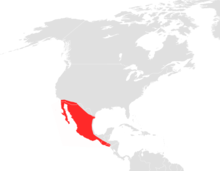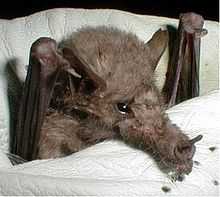Mexican long-tongued bat
| Mexican long-tongued bat | |
|---|---|
 | |
| A Mexican long-tongued bat drinking from a hummingbird feeder | |
| Conservation status | |
| Scientific classification | |
| Kingdom: | Animalia |
| Phylum: | Chordata |
| Class: | Mammalia |
| Order: | Chiroptera |
| Family: | Phyllostomidae |
| Genus: | Choeronycteris |
| Species: | C. mexicana |
| Binomial name | |
| Choeronycteris mexicana Tschudi, 1844 | |
 | |
| Mexican long-tongued bat range | |
The Mexican long-tongued bat (Choeronycteris mexicana) is a species of bat in the family Phyllostomidae. It is monotypic within the genus Choeronycteris.[citation needed] The species is found in El Salvador, Guatemala, Honduras, Mexico, and the United States.[1]

Mexican long-tongued bats feed on nectar and pollen from agaves and other plants. These bats' tongues can extend up to a third of their body length, a feature which makes them uniquely equipped to reach nectar deep inside an agave or cactus blossom. In southern Arizona, long-tongued bats often get nectar from neighborhood hummingbird feeders as well. In the United States, this species is found in the southern parts of California, New Mexico, and Arizona.[1] Their range extends from Mexico through Central America and down to Venezuela. The young are born well-furred for additional warmth in the cool mountain canyons where this species roosts.
See also
References
- ↑ 1.0 1.1 1.2 Arroyo-Cabrales, J. & Perez, S. (2008). "Choeronycteris mexicana". IUCN Red List of Threatened Species. Version 2009.2. International Union for Conservation of Nature. Retrieved 07 February 2010.
| |||||||||||||||||||||||||||||||||||||||||||||||||||||||||||||||||||||||||||||||||||||||||||||||||||||||||||||||||||||||||||||||||||||||||||||||||||||||||||||||||||||||||||||||||||||||||||||||||||||||||||||||||||||||||||||
